When you use something for a thousand years, it is bound to get dirty. Medieval books often show stains and marks on their pages, usually from readers who did not always take very good care of the objects. Medieval books also collected a lot of loose dirt, which sometimes falls out when you thumb through their pages as a modern-day book historian – naturally with clean hands, though preferably without white gloves (here is why). While this dirt is often simply junk, the bits and pieces – twigs, pieces of leaves, dried flowers, pins – may also have had a function. A dried leaf from a tree may for example have been stuck between the pages to serve as a bookmark. In that sense junk can be seen as as a cultural artefact that adds to our understanding of medieval books and their users. Here are some examples of useful dirt.
1. Fingerprints
Considering that every medieval books was handwritten and that their makers will have had inky fingers, you’d expect a lot of ink stains on the page. Surprisingly, medieval pages are almost always free from such stains, perhaps because scribes were careful where they put their dirty hands. Every now and then, however, you encounter an ink stain (Fig. 1).
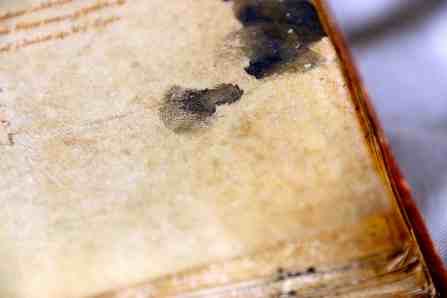
The one seen in Fig. 1 is special because it accompanies an inky fingerprint. This encounter is thrilling. When you place your own finger on top of it, you are suddenly closely connected to a person that lived hundreds of years ago. More importantly, the stain in Fig. 1 adds to our understanding of the book in which it features. Crucial in this respect is the observation that the stain is produced by printers’ ink, which is much blacker and “silvery” than what medieval scribes used. The individual who was attached to the finger was therefore likely a printer. This set of observations prompts an intriguing question: why did a printer in the midst of printing a text feel the need to consult this manuscript? While speculative, the answer may well be that he was actually printing the text on these medieval pages (a work by Bonaventure), meaning that he may have used the handwritten copy to set his type from. This useful information flows directly from dirt that was inadvertently left behind on the page.
2. Leaves and twigs
If you are a regular reader of this blog you will have been introduced to elaborate medieval bookmarks, such as carefully designed parchment disks, glued-on tabs marking the start of a new text or section, or strings of parchment that could be “draped” between pages to identify key passages (see this post). However, medieval readers also produced makeshift bookmarks, made from essentially anything that they found lying on their desk or on the ground, as we still do today. So, we sometimes encounter twigs or pieces of straw, which no doubt ended up in the book to mark a certain page (Fig. 2).
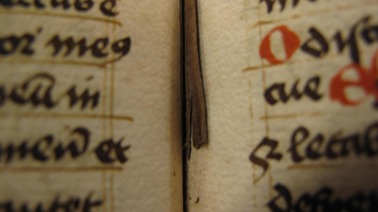
Perhaps an even more natural choice for a bookmark would be a leaf from a tree. I found a particularly nice one tucked away in the back of a volume placed in the chained library in Zutphen, the Netherlands (Fig. 3). The leaf has become hard and may well be as old as the sixteenth century, the date of the book in which it is found. In fact, it feels and looks like a piece of plastic in the shape of a leaf. It may have been put in the back of the book so as to make it easier to find a ready bookmark when it was needed.
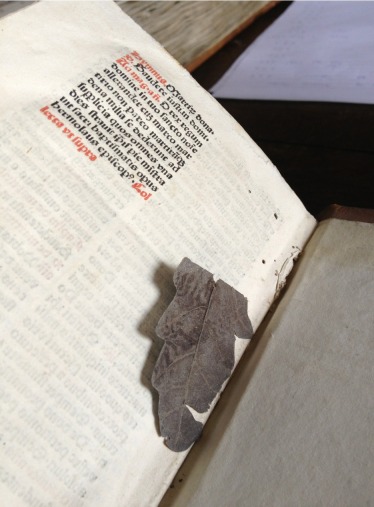
3. Sand
Not so commonly found in medieval books, yet often seen in their seventeenth and eighteenth century counterparts is sand; sometimes lots of it. In fact, when I looked at an account book from 1717 in the Leiden archives not so long ago, a little mountain of sand had piled up when I wanted to close the book (Fig. 4). This is because the sand was used to dry the ink. Text would be added to such account books even after the pages had been folded and bound into an actual book. When a new entry was made (on a blank page), sand was sprinkled on top to as to prevent an offset on the facing page. As with the fingerprint, it is thrilling to touch this sand, knowing that the last person running it through his fingers was an eighteenth-century scribe.
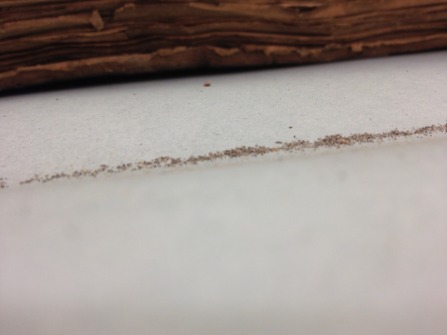
4. Pins
The same account book in Leiden contains many receipts: actual proof of payment made by the municipal government to people working in the town hall (their wages), schools (for the purchase of books) and guards. These receipts (small strips, just a bit bigger than what you get in stores today) were kept in bundles for convenience. There is no easier way to do this than pushing a pin through them (Fig. 5). Pins were also use in both early-modern and medieval books to mark a page. They would not necessarily have to stick out from between the pages: the “bulkiness” of the pin would sometimes be sufficient to guide the reader to a specific page (Fig. 6).
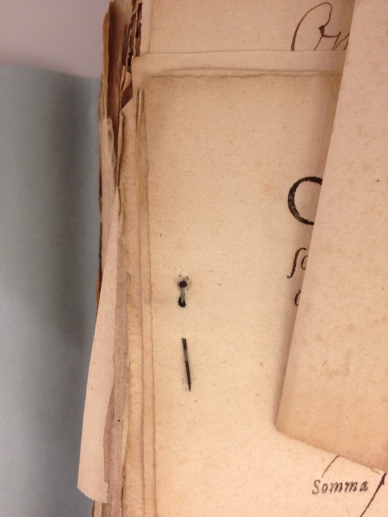
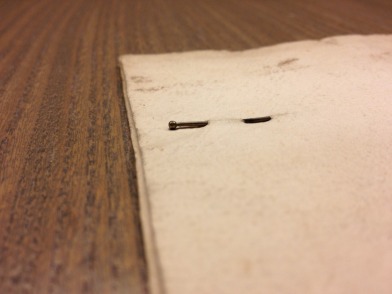
5. Paint
The prettiest “dirt” I encountered – and the only time I found it – is seen in Figs. 6-7. The page in question contains a decorated initial (out of view). After the scribe had copied the page, the decorator would add these with a brush and paint. As he was moving his hand towards to location where he needed to add decoration, in a particularly attractive shade of blue, a drop fell from the brush he was holding. It produced a perfect circle in the lower margin. Interestingly, while such blobs can be removed quite easily when they have dried (with a gentle flick of a knife), this one remained. Not only during the production process of the book, but also throughout the object’s centuries of use. I like to think that the previous users of the book shared my feeling that this blue blob is just the prettiest thing ever.
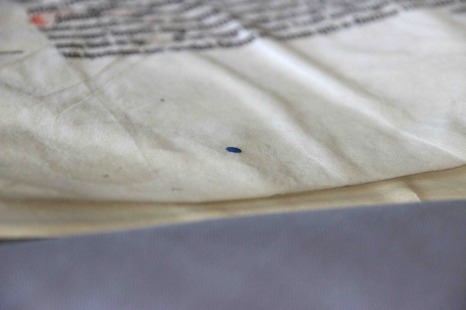
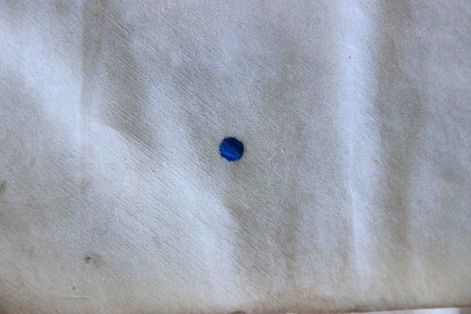
6. Cat paws
Every so often one encounters dirt that is perhaps not particularly insightful as to how a medieval book was used or produced, but it does provide surprising information about the owner, namely that he had a cat (Fig. 8). While this final example brings a “tongue in cheek” conclusion to an otherwise serious post, it does show that books apparently lay open on a desk unattended by the owner. Curiously, it is not the only example of a cat having free access to an open manuscript. Less well known than this inky-cat-paws manuscript (which went viral after my tweet back in 2013; more here) is another book “touched” by a cat, currently kept in Balliol College Oxford (Fig. 9). Here, too, we find evidence of a cat walking over an open book, although this time the paws were dirty, not inky.
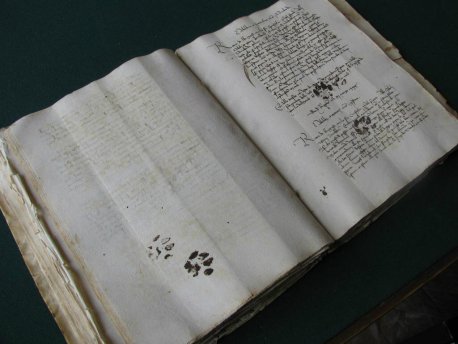
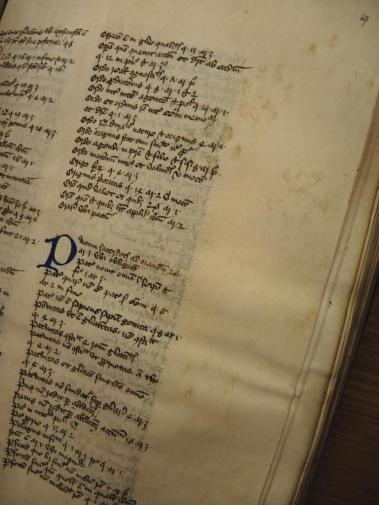
While we are perhaps inclined to regard dirt as an unwanted addition to the medieval book – which is an object that should be spotless, after all – the bits and pieces shown here act as historical clues that shed light on how a book was produced or used. There is an interesting parallel to be drawn with the concept of “damage”. This, too, is often seen as a flaw when encountered in a precious medieval book, while, in fact, it may offer crucial information about how the object was used (see this post). Dirt is an intrinsic part of the historical artefact that is the medieval book and deserves to be studied as such.


Rats, this post wasn’t about all the sly bits of innuendo and intimate bedroom activity references that litter medieval literature. =) I thoroughly enjoyed taking a class in college on Arthurian literature and wrote a paper about how funny the material can be. All the ladies seemed to be named ‘Elaine’, the perils of wandering into an unknown pavilion in the wood, all the double entendres about Lancelot and Guinevere, and Sir Thomas Mallory’s prim prudery in denouncing lusty activities but amazingly doing so with such frequency you have to wonder whether he was protesting too much. Medieval lit is fabulous and made ‘Egad!’ one of my favorite exclamations.
LikeLike
Years ago, I saved my taxes in spiral notebooks, and I needed to keep the receipts. Stapler would not go as far in as I needed it to, so I used pins. My pins are still in my tax books from all those years ago, I thought I was being original. Loved your article.
LikeLike
Thanks for your comment!
LikeLike
Nice post! I enjoyed old pièces of evidences for previous usages and cultural practices. In South East Asia and particularly in India, leaves ( Neem, tabacco, Nigella, curcuma, tulsi ) and seeds are deliberatly placed between pages as insect repellents. For Neem leaves, insecticide properties have been scientifically demonstrated! Please see link of my article on the subject:
https://www.academia.edu/7683384/Of_books_and_men_Part_II_pest_control_in_Indo_Islamic_manuscripts
LikeLike
Thanks for your comment. I didn’t know pins were also used in liturgical books.
LikeLike
Fantastic post! Especially the cat “evidence”… I’ve been working with two sixteenth-century antiphonaries which also have several small papers pinned to the folios (added in the eighteenth century). In the first weeks I started working on them had to be very careful… but now almost know by memory where are the pins.
all best,
LikeLike
These are the things that endear me to old books. Oh, sure, the text often provides information I am looking for, but the joy is in the little artifacts and bits of debris that reveal something of the life of the book and its user(s). So pleasing to see not one, but two books with cat prints. I have several more recent examples myself. (I am much less sanguine when said cat approaches my textiles, however.)
LikeLike
Beautifully explained! These ‘accidental’ bits of debris assume a new identity over time, I suspect, like ‘accidental’ art.
LikeLike
Reblogged this on Books I've Enjoyed (and some I haven't).
LikeLike
Couldn’t agree more!
LikeLiked by 1 person
Imagine determining the book’s provenance by determining what flower you are dealing with. I know of at least one scholar who has attempted to do this.
LikeLike
I really enjoyed this post, and the sense of how thrilling these seemingly unimportant – or even corrupting – additions to medieval manuscripts really are! It reminds us that these were not always historical artifacts but lived in people’s homes.
LikeLiked by 2 people
Other scientists could glean a great deal of information from this debris: botanists, geologists, microbiologists. There’s a couple of hundred thesis (pl. thesae?) waiting to be written!
LikeLiked by 1 person
The more things change the more they stay the same.
LikeLiked by 1 person